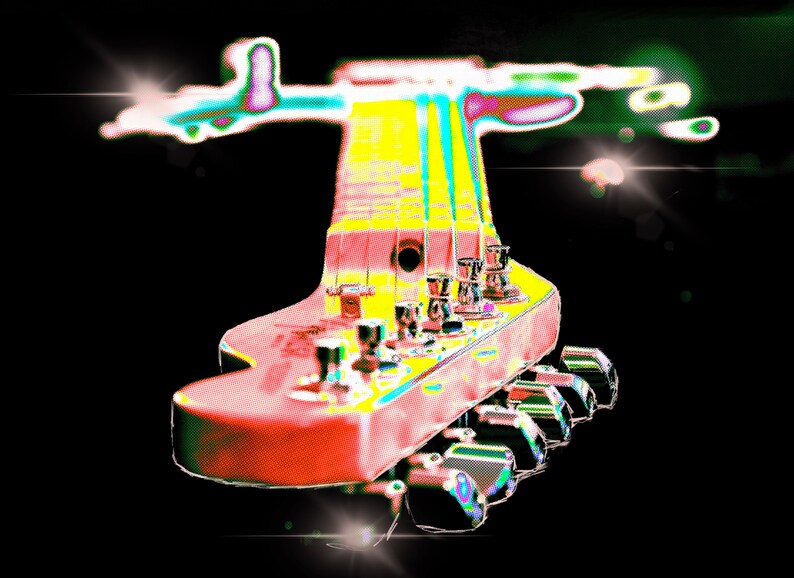|
Digital collage/illustration artwork called, "Headstock" by Nick Venturella When people buy art, or respond with appreciation to a piece of art, music or writing, what are the factors in play that make that art resonate?
It's a connection, or rather an appeal that leads to a connection. The art first piques the interest of the viewer/listener/reader and that artistic content -- the visuals/the melody/the words used to describe something -- appeals to that audience's own emotional biases; their own sense of self-expression (how they see themselves and/or how they want to be seen). There is a lot wrapped up on those emotional biases. A big one is nostalgia -- when the art reminds the audience of a positive or heart-warming past experience. This makes the appeal "stickier" (aka harder to resist) for those whom the nostalgic content (aka the positive memories the art invokes) resonates most. The point is, for art to effectively connect with an audience to motivate that audience to some sort of action -- share on social promoting the art, click through to learn more, or to buy something -- it needs to appeal to the audience's emotional biases and resonate enough to motivate that action. How do you actually motivate the kind of action you want your audience to take? You have to do some research to find out what emotional biases your art appeals to most, and for which people. This is the hardest part of marketing and promoting anything -- art, a product, a business. In an over simplified business perspective, this kind of research is called product/market fit. That is, regarding the product you make, who are the people your product could help most? Meaning, that audience has the most demand for and willingness to pay for your product and the solution it provides. Huh, the solution it provides...that's something to explore in art. What solution does art (visual, music, writing) provide? Usually, art is providing some sort of emotional connection to motivate action. The art is the product. The emotional connection it creates for the audience is the solution it provides. The outcome to that solution could be to motivate an individual to listen to the song again, to escape into a fantasy world, often to buy the art or a product that is using the art to help sell it. Art is a communication vehicle. A very powerful and effective one when used well. Art alone, however, leaves that vehicle motionless. That vehicle wants to go somewhere. It wants to drive to pick up some friends. It longs for the attention of others who understand it. That's why art is not only a communication vehicle, but a community cultivator. As humans -- whether introverted or extroverted -- we long for some amount of community. That could be with one other person or thousands of people (think of a bunch of fans just like you at a concert of your favorite musical act). Art communicates to the emotional biases of individuals, but it has far more power and arguably more appeal when those individuals with similar emotional biases stoked by the art that resonates similarly to them, find one another and form a community -- a shared reason for coming together. When community forms like this, more communication between the art and the community audience exists. The art becomes the connection point or ongoing communication vehicle between the artist and their audience. This is where/when co-creation of the art via communication with the audience gives way to new ideas and possibilities. At this point, the human connectedness is at a critical mass enough to allow the art and the community around it to become something new entirely, but based on the shared emotional bias and appeal from which things started. The best art is made for the artist, because the artist felt compelled to explore an idea that they fleshed out further into more of a complete work or finished creative thought. The reason that’s the best art is because it comes from a pure and authentic frame of mind with no hidden agenda (like to sell). However, once it’s created because of its genuine authenticity it is more relatable and tends to resonate better with others (not everyone, mind you, but those who identify with what the art represents and how it makes them feel). That’s the art that often ends up gaining a following (a community) because it was born out of true, authentic intentions from the artist. Art that is made for the sole intention to sell often lacks depth — the art’s soul is missing, and people notice that. That is not to say that people who make art to make their living end up, making soulless art, the true professional artists, typically are able to make money from it because they get into the mindset where they’re creating the art for themselves to scratch the itch of a curiosity that they're compelled to explore to realize an expression that is inside of them first, and then once it's out there, are able to attract an audience for whom that resonates, and that’s why it sells. |
Invest in yourself. Get creative/business/life insights in your inbox - sign up for my eNewsletter.
Archives
July 2024
|


 RSS Feed
RSS Feed

